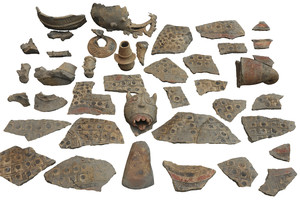
EDIVALDO PEREIRA
Ceramics from archaeological sites in Santarém portray human/animal hybrid figuresEDIVALDO PEREIRAA paper by archaeologist Denise Maria Cavalcante Gomes, from the Federal University of Rio de Janeiro (UFRJ), argues that indigenous peoples who lived in the Santarém region of Brazil between the years 1000 and 1600 developed complex societies that involved socio-political organization marked by the emergence of leadership structures, but did not live under a centralized power (Cambridge Archeological Journal, May 2017). Between 2006 and 2016, Gomes studied the layout and structure of 30 archaeological sites in a 500-square-kilometer area, analyzing the iconography of ceramics found in the region and the ethno-historical accounts of chroniclers who passed through the Amazon in the sixteenth and seventeenth centuries. In the area that today is the center of Santarém, there were two large villages separated by a lake, which has now dried up. According to carbon dating, they were contemporary settlements with a high population density. Those who lived there maintained relationships, hunted, and fished on the banks of the Tapajós River. According to Denise, there was a demographic explosion in these two villages in the fourteenth century that generated conflicts and social separations between the inhabitants, leading many to disperse and create smaller, independent villages. “The ceramics from all the sites contain human/animal hybrid figures, alluding to the notion of bodily metamorphosis, which is related to the idea of instability,” comments the archaeologist.
Republish
